Éponge rouge écarlate
Porifera, Demospongiae, Poecilosclerida, Microcionidae
Clathria (Microciona) atrasanguinea (Bowerbank, 1862)
Description :
L’éponge rouge écarlate est de couleur rouge sang dans la zone intertidale. Elle est encroûtante et si peu épaisse que les motifs du substrat transparaissent sous son corps. Sa surface est veloutée et sa consistance est douce (van Soest et al., 2000).
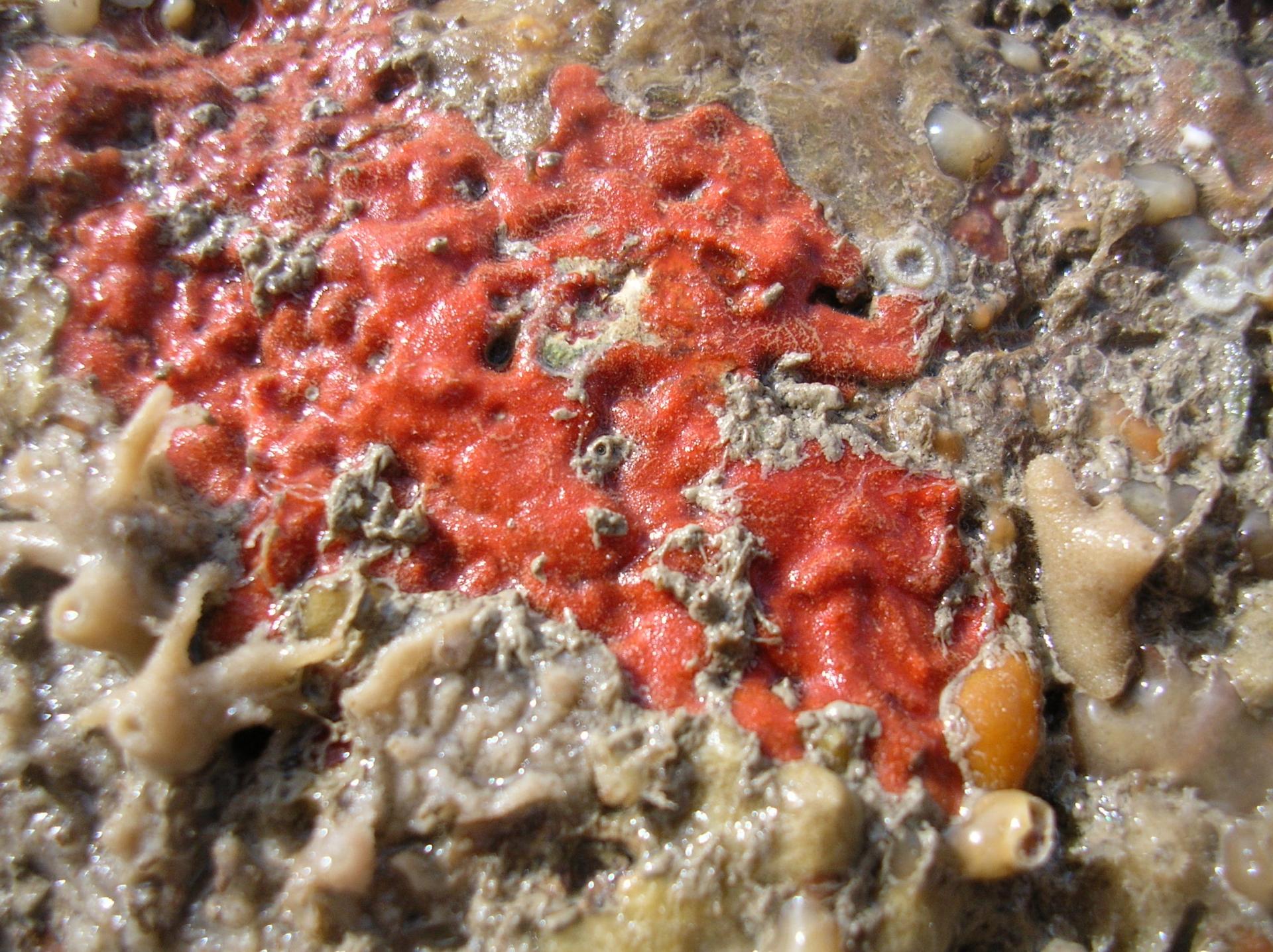
L’éponge rouge écarlate (Clathria (Microciona) atrasanguinea (Bowerbank, 1862)) parmi d’autres espèces d’éponges.
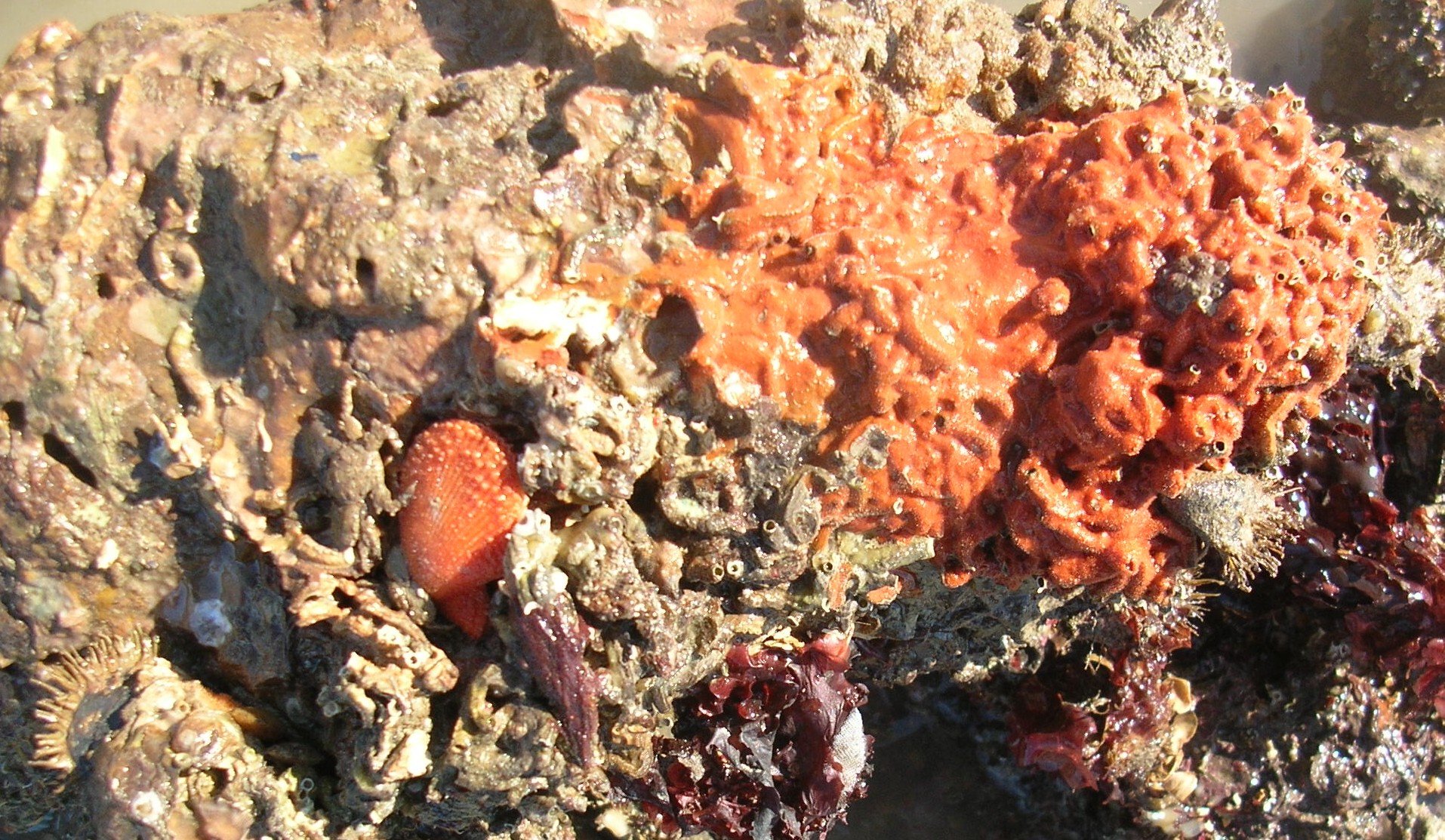
L’éponge rouge écarlate sur une coquille de pétoncle (Mimachlamys varia (Linnaeus, 1758)) et sur un rocher calcaire.
Écologie :
Elle s’observe dans le sous étage médiolittoral inférieur et la frange infralittorale, sous les rochers ou sur les surfaces verticales, dans des eaux peu salées. Cette éponge est souvent sur les coquilles de pétoncles. Elle est mangée par des nudibranches comme Rostanga rubra (Hayward & Ryland, 2003). Ce dernier recycle les pigments de l’éponge pour colorer ses téguments et se dissimuler vis à vis de ses prédateurs.
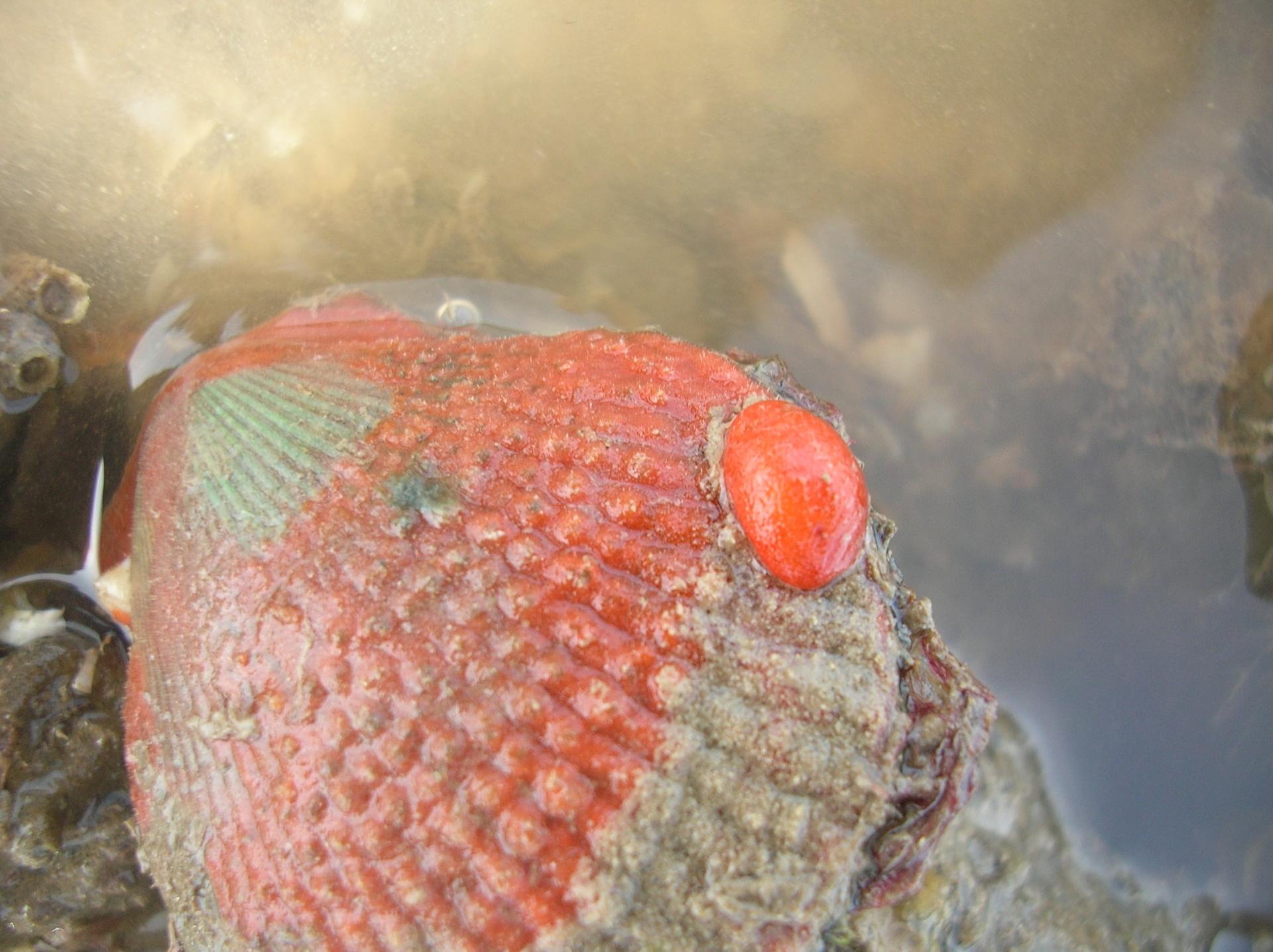
L’éponge rouge écarlate broutée par un Mollusque Nudibranche (Rostanga rubra (Risso, 1818)) possédant les mêmes pigments.
Distribution :
Côtes atlantiques de l’Europe, du sud des îles Shetlands jusqu’aux Açores et à la mer Méditerranée (Picton et al., 2011).
Spicules :
Les principaux spicules du squelette sont des subtylostyles recouverts d’épines seulement sur leur tête (110 à 375 µm de long x 10 µm d’épaisseur). Les subtylostyles secondaires sont rectilignes et étroits (leur longueur est de 225 à 355 µm) Les acanthostyles sont recouverts d’épines sur toute leur longueur. Ils mesurent de 80 à 135 micromètres (Picton et al., 2011).
Remarque : Seuls les mégasclères ont pu être observé par la technique utilisée.

Acanthostyle de Clathria (Microciona) atrasanguinea (Bowerbank, 1862)
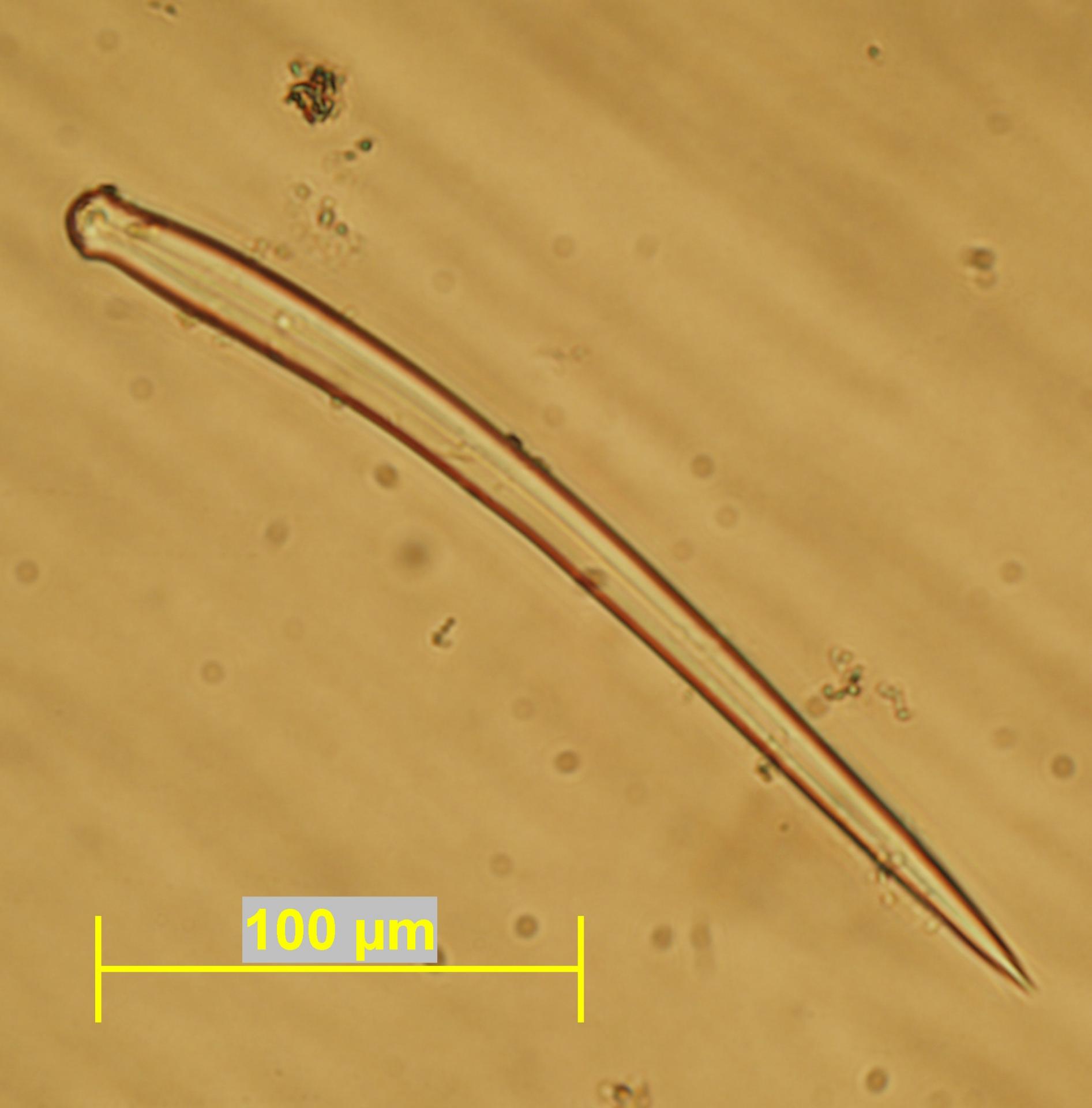
Subtylostyle principal de Clathria (Microciona) atrasanguinea (Bowerbank, 1862)
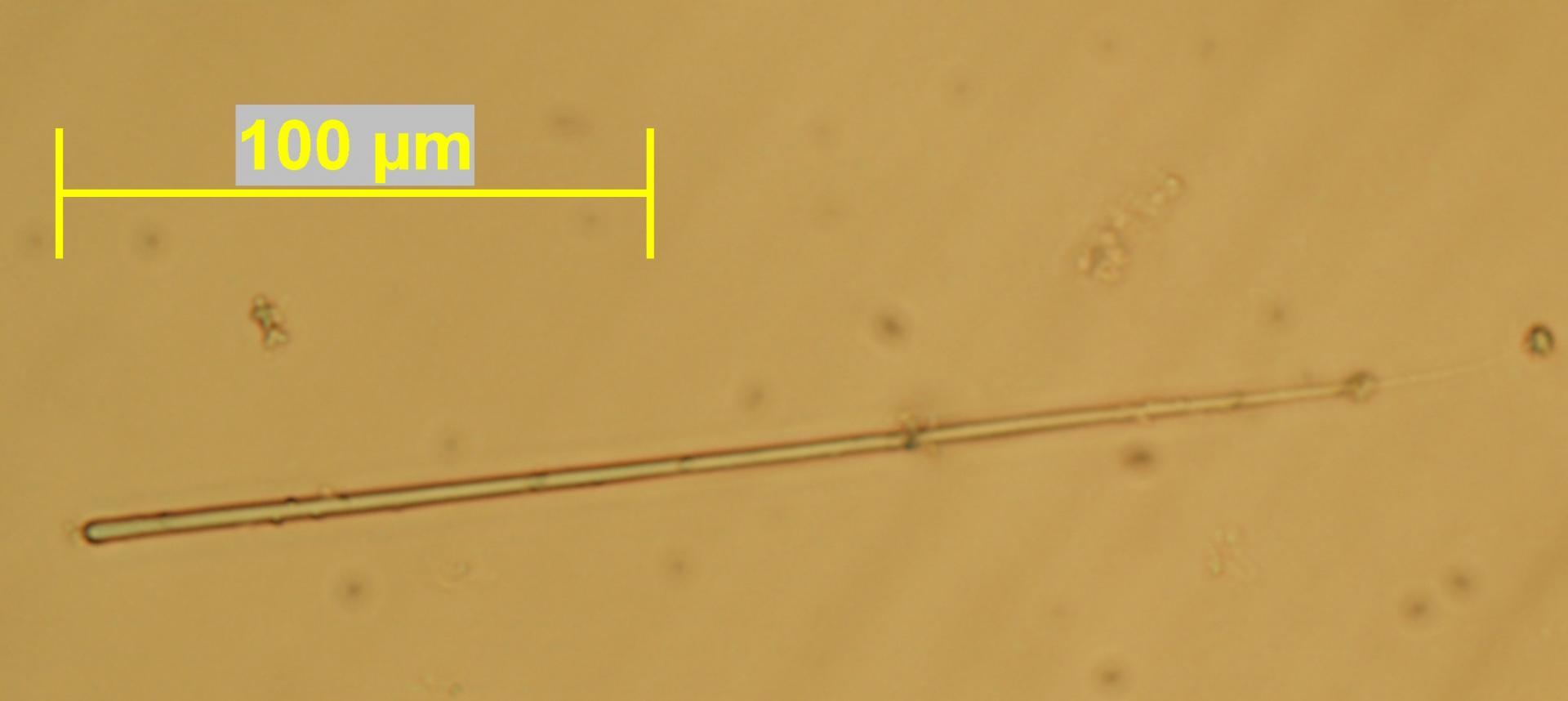
Subtylostyle secondaire de Clathria (Microciona) atrasanguinea (Bowerbank, 1862)
Références bibliographiques :
Hayward, P. J. & Ryland, J. S., (2003) Handbook of the Marine Fauna of North-West Europe, Oxford University Press, ed. 6e, pp.800.
Picton, B. E., Morrow, C. C. & van Soest, R. W. B., (2011) in Sponges of Britain and Ireland. (http://www.habitas.org.uk/marinelife/sponge_guide/sponges.asp?item=C3590, 25.08.2011.
van Soest, R. W. M., Picton, B. E. & Morrow, C., (2000) Sponges of the North East Atlantic, in World Biodiversity Database CD-ROM Series, Windows/Mac version 1.0. ( ETI, University of Amsterdam: Amsterdam).
Clathria (Microciona) atrasanguinea (Bowerbank, 1862)
Description:
The scarlet red sponge has a blood red colour in the intertidal zone. It is one of the encrusting sponges and so thin that the structure of the substrate is visible through his body corps. The Surface of this sponge is velvety and the consistency is soft (van Soest et al., 2000).
Habitat:
This sponge lives in the mediolittoral and the infralittoral zones under the stones and on vertical surfaces in brackish water. It occurs often on the shells of scallop. It is eaten by some molluscs’ nudibranchia like Rostanga rubra (Risso, 1818) (Hayward & Ryland, 2003). This species used sponge pigments to color its épiderme and to dissimulate itself from its predators.
Distribution:
Atlantic coasts of Europe from Shetlands southwards, Mediterranean (Picton et al., 2011).
Spicules:
Principal spicules of the main skeleton are subtylostyles (rarely sparingly spined at the base) which measure 110-(250)-375µm long x 10µm thick. Slender accessory subtylostyles measure 225-(260)-355µm. Acanthostyles (Auxiliary megascleres) are entirely-spined, 80-(90)-135µm (Picton et al., 2011).
NB : With the technic used megascleres are the only spicules wishes have been seen.
References:
Hayward, P. J. & Ryland, J. S., (2003) Handbook of the Marine Fauna of North-West Europe, Oxford University Press, ed. 6e, pp.800.
Picton, B. E., Morrow, C. C. & van Soest, R. W. B., (2011) in Sponges of Britain and Ireland. (http://www.habitas.org.uk/marinelife/sponge_guide/sponges.asp?item=C3590, 25.08.2011.
van Soest, R. W. M., Picton, B. E. & Morrow, C., (2000) Sponges of the North East Atlantic, in World Biodiversity Database CD-ROM Series, Windows/Mac version 1.0. ( ETI, University of Amsterdam: Amsterdam).
Commentaires (1)
- 1. | 11/02/2025
Ajouter un commentaire
Date de dernière mise à jour : 26/11/2015

Whatzap +33 7 45 90 33 11
Obtenir un approuvée diplôme valide avec vérification en ligne sans exame.Whatzap +33 7 45 90 33 11
Inscription instantanée 100% authentique Duolingo test d'anglais, Ielts, Toefl, Toeic sans examen(Whatzap +33 7 45 90 33 11 )
Whatzap +33 7 45 90 33 11 )obtenir 100% authentiques voltaire,BPJEPS,DUOLINGO anglaise TEST,NEBOSH, PTE, GMAT, PMP, A1, A2, B1, B2, C1, C2, GRE, ESOL TOEIC ,IELTS, TOEFL, PMP, CISSP, SANS EXAMEN / Passeports, permis de conduire, cartes d´identité, visas, certificats de naissance, diplômes, fausse monnaie, $ ,? £ /DILF, DELF, DALF, TEF, TCF, TFI, PMP, CAPM, RMP et PRINCE2 en ligne sans examen. la vérification en ligne est réalisable à 101 %
Whatzap +33 7 45 90 33 11 )
INSTANT 100% ENREGISTRÉ voltaire,BPJEPS,DUOLINGO English TEST,IELTS, TOEFL, CISSP TOEIC, PMP, PTE, GMAT SANS EXAMEN PASSEPORT, CARTE D'IDENTITÉ, VISA, PERMIS DE CONDUIRE,
BESOIN d'un certificat DUOLINGO English TEST,IELTS / TOEFL / ESOL / GRE / PTE / GMAT / Nebosh / CELTA / DELTA VÉRIFIÉ de toute urgence en Australie, Arabie Saoudite, Oman, Liban, Qatar, Canada, Inde, Dubaï, Iran , Pakistan, Biélorussie, Koweït, Allemagne, France,
Commandez un permis de conduire authentique, un visa, un passeport, des cartes d'identité, des certificats en ligne // (+27838808170))Achetez 100% authentique IELTS, TOEFL, PMP, CISSP, SANS EXAM/Passeports, Permis de conduire, Cartes d'identité, Visas, Contrefaçon Money,$,?£: Nous utilisons des équipements et des matériaux de haute qualité pour produire des documents authentiques et contrefaits. Toutes les caractéristiques secrètes des vrais passeports sont soigneusement dupliquées pour nos documents enregistrés et non enregistrés. Uniquement des passeports, permis de conduire, cartes d'identité, timbres, visas, diplômes scolaires et autres produits enregistrés et non enregistrés d'origine pour un certain nombre de pays comme*:*USA, Australie, Belgique, Brésil, Canada, Italien, Finlande, France, Allemagne, Israël, Mexique, Pays-Bas, Afrique du Sud, Espagne, Royaume-Uni.(priceali190@gmail.com)
(115) score de bande dans le test duolingo - Est réalisable : (WHATSAPP +33 7 45 90 33 11) valid Inscription instantanée